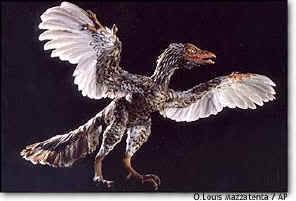Historical Lies of Evolution
"Archaeoraptor": The $80,000 Fake Dino-Bird
from National Geographic

National Geographic boldly proclaimed to the world in a six-page color article that "Archaeoraptor liaoningensis" was "a true missing link in the complex chain that connects dinosaurs to birds." The discovery was later found to be an embarrassing combination of two completely different animals. For some in the scientific community, the nature of Nat Geo's retraction was almost as embarrassing as the lies it published.
The Fossil Remains
In March, National Geographic published a letter, of less than 90 words, written by Xu Xing, one of the scientists who originally examined the "Archaeoraptor," in the magazine's "Forum" section. "People who were looking for the retraction couldn't find it," DeWitt said. "A letter to the editor is not the usual way to handle an error of this magnitude."
In stark contrast to their sensationalistic ‘Feathers for T. rex’ article, National Geographic has printed a brief, yet revealing statement by Xu Xing, vertebrate paleontologist from the Chinese Academy of Sciences, in Beijing. Xu's revelation appears in the somewhat obscure Forum section of the March, 2000 issue, together with a carefully crafted editorial response. The letter from Xu Xing, vertebrate paleontologist from the Chinese Academy of Sciences in Beijing, reads:
‘After observing a new feathered dromaeosaur specimen in a private collection and comparing it with the fossil known as Archaeoraptor [pages 100–101], I have concluded that Archaeoraptor is a composite. The tail portions of the two fossils are identical, but other elements of the new specimen are very different from Archaeoraptor, in fact more closely resembling Sinornithosaurus. Though I do not want to believe it, Archaeoraptor appears to be composed of a dromaeosaur tail and a bird body.’
The Perpetrators
The "true missing link" fossil was created by Chinese craftsmen, smuggled into the United States from China and was sold for $80,000 to the owner of a dinosaur museum in Monticello, Utah, before it eventually landed in the halls of the National Geographic Society in Washington.
In a six-page color spread, complete with artist's drawings, photographs and diagrams, National Geographic's November 1999 issue reported that the "Archaeoraptor," supposedly a 120-million-year-old bird-like creature with the tail of a meat-eating dinosaur, had been discovered in a fossil unearthed in the remote Liaoning Province of China.
The $80,000 FAKE FOSSIL had also been showcased before more than 100,000 people, the majority of them children, at the National Geographic's Explorers Hall in Washington between Oct. 15 and Jan. 21.
As more evidence of altered fossils begins to surface, one must seriously question the integrity of the fossil industry and the stories these fossils are supposed to tell. A Feb. 19, 2000 New Scientist article sheds light on the growing problem of faked and altered fossils. Referring to the Chinese fossil birds, paleontologist Kraig Derstler from the University of New Orleans in Louisiana says, ‘almost every one that I’ve seen on the commercial market has some reconstruction to make it look prettier.’
The illegal yet highly profitable market of Chinese bird fossils has enticed the local farmers into creating marketable fossils, real or not. Derstler points out that ‘adhesives and fake rock have become very easy to make and very difficult to spot.’
The paleontologist Luis Chiappe, of the Natural History Museum of Los Angeles County, describes how one such specimen almost fooled him, till he noticed that one leg was longer than the other. ‘I wasn’t sure what was wrong with it,’ Chiappe said. Only close examination revealed that two slabs had been mortared together. ‘On the surface you really couldn’t see that.’
Dr Larry Martin of the University of Kansas, who is a staunch critic of the dino-to-bird theory, commented, ‘I don’t trust any of these specimens until I see the X-rays.’ 6 Joints and gaps in the reworked fossils are revealed with X-rays. Martin went on to say:
‘The farmers do not believe this is wrong, they look at it as restoring an art object to make it more marketable. The whole commercial market for fossils has gotten riddled with fakery.’
A General Warning
"Archaeoraptor" illustrates the danger of publishing so-called factual "evidence" regarding the notion of macroevolution. Evolutionists still base new taxonomic classifications on nothing but obscure fragments and teeth. DeWitt noted he is concerned that the scientific community's predisposition toward evolution too often takes precedence over objective scientific research.
"Many scientists are so convinced that Darwinism is correct that they can't even see the plain evidence that contradicts it," DeWitt said. "Because they only look for evidence that supports the theory, they can be easily duped. The Archaeoraptor incident shows what can happen when scientists fail to consider alternative explanations."
http://www.answersingenesis.org/docs...ws3-2-2000.asp
http://www.discovercreation.org/newl...ril%202000.htm
http://www.worthynews.com/news-featu...sing-link.html